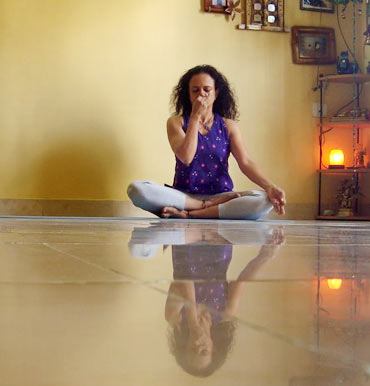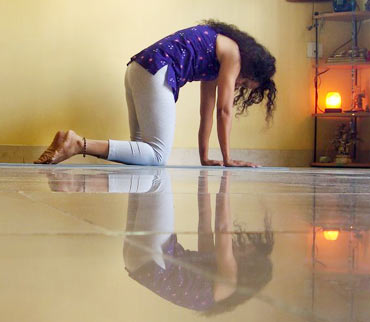
Yoga during pregnancy is a great way to ensure you have a comfortable delivery. However, since this decision is normally taken by several women who have been largely inactive before pregnancy, it is important to seek a personalised programme to ensure it complements your current physical health. Also, the practice must be in a special pre-natal class or only with an expert who can assure you personal attention.
This is important: each trimester different yoga poses and practices are advised.
Also, in each trimester some poses must be completely dispensed with. Joining a large general class or trying to practice from a book or the net would be counter-productive. There are lots of do's and don'ts for yoga during pregnancy, so attending a general class would be ill-advised. Even classic poses must be modified to accommodate the swelling abdomen. Women who have been doing yoga can have a different chart from rank new comers, but they too need to do only modified classic practices.
Celebs like Gisele Bundchen and Gwyneth Paltrow have popularised yoga during pregnancy, not only to retain their shape post-delivery, but also to ensure a comfortable delivery.
Some important guidelines:
Disclaimer: This column only seeks to share the author's enthusiasm towards yoga. Yoga is best learnt under expert guidance.
Shameem Akthar, yoga acharya trained with the Sivananda Yoga Vedanta Center, takes you through a few safe practices during pregnancy. However, remember to use this column only as a general guide; it is extremely important to practice a personalized programme with an expert pre-natal yoga teacher. Also, even classic poses, including the corpse or shavasana, has to be modified to accommodate the widening abdomen.
Catch more of Shameem's yoga writings or upcoming workshops from https://jaisivananda.blogspot.com

Do a modified form without any retention. Sit in any cross-legged position, or even in chair. Keep left hand in chin mudra, and right hand in Vishnu mudra, with index and middle fingers bent, using the remaining fingers to shut and open the nostrils.
Inhale and exhale twice, deeply. Then closing the right nostril, inhale from left to a count of two. Then shut the left nostril, to exhale from the right to a count of four. Inhale from the right to a count of two, and exhale from left to a count of four. This is one round. Do up to nine rounds. After a few weeks, you may double the ratio to four-count inhalations and eight-count exhalation.
Benefits: Creates calmness and mental harmony. Increases the pranic energy or life force, so the growing baby enjoys and benefits from the mother's vitality.

Sit back, with your hips rested on your heels. Lean forward, so palms are rested on ground, under either shoulder. Inhale, lifting your head up and dropping your spine in.
Exhale, drop your head to lock chin between collar bone. Arch spine. Tighten arms and legs. This is one round.Do up to five rounds.
Benefits: Stretches the spine and strengthens the back which gets to feel the weight of the growing womb.Improves deep breathing.
The other two areas which must be given special attention -- like the belly and pelvic region during this period -- are also gently worked out.

Lie on your back. Fold legs at the knees. Keep feet close to the hips. Reach hands to grasp each ankle. Inhale and raise hips. Exhale to gently drop it back to ground. Do five times.
Benefits: This pose services the back, spine and pelvic region which all intensely feel the pressure of pregnancy and childbirth.

This is the best pose for relaxing once the belly begins to broaden.
Lie on your left side, left arm bent to cushion head, while left leg is straight. The right hand is bent and placed on the floor or a cushion. The right leg is also bent and placed either on the cushion or floor.
A cushion helps give more breathing place as the stomach begins to expand with the growing child.
Benefits: It takes the pressure off the abdomen, is very relaxing, and encourages deep breathing naturally.